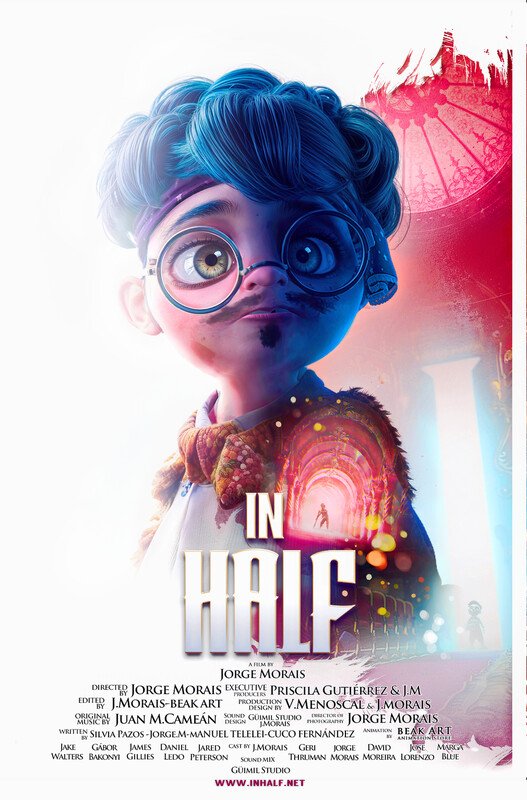
In Half – Best Animation
Through a child’s imagination it tells the journey of a man who after falling prey to his fears, he must cross a strange world, a universe full of magic, where he will be confronted with his own fears and conflicts from the past and where he must find solutions for the future to discover his self-identity.
Director Biography - Jorge Morais Valle
Jorge Morais is a distinguished independent filmmaker and artist hailing from Vigo, Spain. His artistic journey commenced at a young age, deeply entwined with various disciplines, including drawing, painting, and sculpture. Notably, sculpture emerged as his primary focus early in his creative development.
Morais entered the realm of graffiti and mural painting during his formative years, where he cultivated a unique style of expression that garnered the attention of commercial brands seeking artistic and advertising collaborations. This early exposure facilitated his transition into the fields of decoration and theatrical stage design, where he successfully led teams on projects across Spain and Portugal, even before completing his secondary education.
Throughout his career in Fine Arts, Morais adeptly navigated various professional realms, including scenography, painting, and illustration in both Galicia and Portugal. His multifaceted experiences culminated in a series of collaborative projects, painting exhibitions, and advertising campaigns. He also spearheaded a collective of emerging artists known as New Order Productions, which enriched his artistic repertoire and honed his leadership capabilities—qualities that would later empower him to venture into the field of animation following his graduation from the Faculty of Fine Arts.
In 2010, Morais premiered his inaugural animated short film, The Painter of Skies, as the capstone project for his Master’s degree in animation. The film garnered significant national and international acclaim, achieving selection in over 300 festivals and amassing 125 awards globally. This transformative experience served as a catalyst for a series of travels to esteemed studios and production companies across Portugal, India, England, Italy, and Germany. Throughout this journey, he immersed himself in a variety of projects that not only broadened his skill set in production design, animation, modeling, and kinematics but also significantly enhanced his professional reputation within the animation industry. Each engagement provided unique insights and opportunities for collaboration, ultimately contributing to his comprehensive understanding and mastery of the field.
Director Statement
I believe that animation has the power to transcend boundaries and connect people on a deeper level. Through my work, I aim to explore complex themes and emotions that resonate with viewers of all ages. I am committed to bringing diverse voices and perspectives to the forefront, and using the medium of animation to spark conversation and foster empathy.
I believe that animation is a powerful tool for storytelling, and I strive to push the boundaries of what is possible in the medium. I am constantly seeking new ways to innovate and challenge myself creatively, in order to create work that is both visually stunning and emotionally resonant. My goal is to create animation that not only entertains, but also leaves a lasting impact on its audience, challenging them to think critically and feel deeply.
I am dedicated to creating stories that are inclusive, thoughtful, and thought-provoking. I strive to create characters that are diverse, complex, and authentically represented. I believe that by centering the stories of underrepresented communities, we can create a more inclusive and empathetic world.
Above all, I aspire to create animation that is meaningful, inspiring, and memorable. I am committed to using my platform as a filmmaker to shine a light on important and often overlooked stories, and to create work that has a lasting impact. Through my animation projects, I hope to inspire others to think, feel, and connect with each other in a deeper and more meaningful way.
_ Jorge Morais
*** Psychological Development in the Project ***
By Adele Baker, University of Edinburgh, School of Philosophy
Teaching children to effectively manage their emotions is arguably one of the most invaluable gifts we can offer them, serving as a fundamental tool for their growth as individuals. Throughout this journey, children begin to comprehend their emotional landscape, making it essential for us to closely observe their behaviors.
The short film In Half primarily explores the emotions of fear and love. While it is common to equate the opposite of love with hate, these two extremes are actually unrelated. In truth, fear stands as love’s true antithesis. Renowned Swiss psychiatrist and psychoanalyst Carl Gustav Jung posits that we all harbor certain traits that we conceal; from an early age, we learn that such concealment is necessary for acceptance. These unacknowledged traits become our “shadow,” emerging at various stages in our lives. In conjunction with this shadow, we develop what Freud referred to as the “ideal self”__a mask we create to blend into our surroundings and avoid rejection.
The inability to accept our shadow can lead to various issues, including trauma. When we struggle to embrace ourselves out of fear, we find it difficult to love ourselves. Fear indeed represents the antithesis of love. We are often unable to love ourselves due to our fear of self-identity, which in turn complicates our capacity to extend love to others.
This philosophy of navigating the world—sometimes successfully, yet always with effort—is poignantly illustrated in the animated short film In Half, written and directed by Jorge Morais. The narrative captures the internal struggle of a five-year-old boy as he grapples with the emotional barriers erected by fear.
Young Vivencio, a cheerful and imaginative child, is raised under the strict discipline of his father, Mr. Crabby. His father’s unconventional teaching methods and values create significant emotional turmoil for Vivencio, distancing him from his mother and prompting him to confront his fears through introspection. It is within this inner journey that he learns the importance of facing challenges by breaking free from the metaphorical cage that confines him, striving to resolve his dilemmas through logic.
The film also highlights a vital theme: Vivencio’s progression through his projected fears is rooted in the innocence he embodies. This innocence allows him to perceive the world through a unique lens, distinct from that of most adults, as he marvels at everything and learns in a pure, stereotype-free manner.
By the film’s conclusion, accompanied by meticulous, beautiful, and sensitive animation, we are reminded of the crucial role that role models and parental love play in a child’s education. Whether through imposing their own path or fostering personal growth, parental guidance is indispensable.
It is important to dismiss the notion that children must suffer or navigate life flawlessly; such beliefs should not result in the restriction of their freedom. As previously mentioned, it is often these “dangers” or challenges that enable us to develop our best adaptive capacities, as well as our unique perspectives and decision-making abilities.
Ultimately, the character of the child imparts profound lessons, one of the most significant being that the fear of fear is a constant companion throughout our lives. Overcoming this fear lies not merely in acts of bravery or courage, but in the emotional maturity cultivated from childhood experiences.
The final message of this short film serves as a poignant reminder for adults: we must not allow our inner child to fade, as it occupies a vital space within our hearts. Embracing this inner child enables us to view the world with wonder and joy, empowering us to confront any challenge that life presents.


0 Comments
Comments are closed.